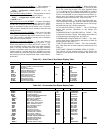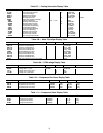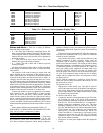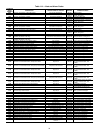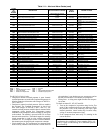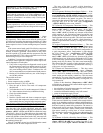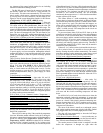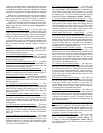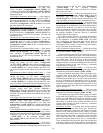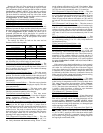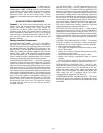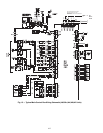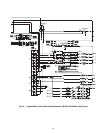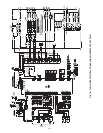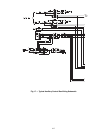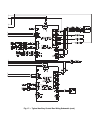
99
T301 (Space Temperature Above Limit)
— If the space tem-
perature is above the configurable SPT High Alert
Limits (occupied [Configuration
ALLM
SP.H.O] for
5 minutes or unoccupied [Configuration
ALLM
SP.H.U]
for 10 minutes), then an alert will be broadcast. The alert will
automatically reset.
T302 (Supply Temperature Below Limit)
— If the supply-air
temperature measured by the supply temperature sensor is
below the configurable SAT LO Alert Limit/Occ (Configura-
tion
ALLM
SA.L.O) for 5 minutes or the SAT LO Alert
Limit/Unocc (Configuration
ALLM
SA.L.U) for 10 min-
utes, then an alert will be broadcast.
T303 (Supply Temperature Above Limit)
— If the supply
temperature is above the configurable SAT HI Alert Limit Occ
(Configuration
ALLM
SAH.O) for 5 minutes or the SAT
HI Alert Limit/Unocc (Configuration
ALLM
SA.H.U) for
10 minutes, then an alert will be broadcast. The alert will
automatically reset.
T304 (Return Air Temperature Below Limit)
— If the return-
air temperature measured by the RAT sensor is below the
configurable RAT LO Alert Limit/Occ (Configuration
ALLM
RA.L.O) for 5 minutes or RAT HI Alert Limit/Occ
(Configuration
ALLM
RA.L.U) for 10 minutes, then an
alert will be broadcast.
T305 (Return Air Temperature Above Limit)
— If the return-
air temperature is below the RAT HI Alert Limit/Occ (Config-
uration
ALLM
RA.H.O) for 5 minutes or RAT HI
Alert Limit/Occ (Configuration
ALLM
RA.H.U) for
10 minutes, then an alert will be broadcast. The alert will
automatically reset.
T308 (Return Air Relative Humidity Below Limit)
— If the
unit is configured to use a return air relative humidity sensor
through the Return Air RH Sensor (Configuration
UNIT
SENS
RRH.S) setting, and the measured level is
below the configurable RH Low Alert Limit (Configuration
ALLM
R.RH.L) for 5 minutes, then the alert will occur.
The unit will continue to run and the alert will automatically
reset.
T309 (Return Air Relative Humidity Above Limit)
— If the
unit is configured to use a return air relative humidity sensor
through the Return Air RH Sensor (Configuration
UNIT
SENS
RRH.S) setting, and the measured level is
above the configurable RH High Alert Limit (Configuration
ALLM
R.RH.H) for 5 minutes, then the alert will occur.
Unit will continue to run and the alert will automatically reset.
T310 (Supply Duct Static Pressure Below Limit)
— If the unit
is a VAV unit with a supply duct pressure sensor and the
measured supply duct static pressure (Pressures
AIR.P
SP) is below the configurable SP Low Alert Limit
(Configuration
ALLM
SP.L) for 5 minutes, then the alert
will occur. The unit will continue to run and the alert will auto-
matically reset.
T311 (Supply Duct Static Pressure Above Limit)
— If the unit
is a VAV unit with a supply duct pressure sensor and the
measured supply duct static pressure (Pressures
AIR.P
SP) is above the configurable SP Low Alert Limit
(Configuration
ALLM
SP.H) for 5 minutes, then the alert
will occur. The unit will continue to run and the alert will auto-
matically reset.
T312 (Building Static Pressure Below Limit)
— If the unit is
configured to use a VFD controlled power exhaust or a modu-
lating power exhaust then a building static pressure limit can be
configured using the BP Low Alert Limit (Configuration
ALLM
BP.L). If the measured pressure (Pres-
sures
AIR.P
BP) is below the limit for 5 minutes then the
alert will occur.
T313 (Building Static Pressure Above Limit)
— If the unit is
configured to use a VFD controlled power exhaust or a modu-
lating power exhaust then a building static pressure limit can be
configured using the BP HI Alert Limit (Configuration
ALLM
BP.H). If the measured pressure
(Pressures
AIR.P
BP) is above the limit for 5 minutes,
then the alert will occur.
T314 (IAQ Above Limit)
— If the unit is configured to use an
CO
2
sensor and the level (Inputs
AIR.Q
IAQ) is above the
configurable IAQ High Alert Limit (Configuration
ALLM
IAQ.H) for 5 minutes then the alert will occur. The
unit will continue to run and the alert will automatically reset.
A404 (Fire Shutdown Emergency Mode)
— This alarm occurs
when the fire shutdown input is active (either open or closed
depending upon its configuration). If the fire shutdown input is
energized (fire shutdown is in effect), or if two fire smoke
modes are incorrectly energized at the same time, a fire shut-
down mode will occur. This is an emergency mode requiring
the complete shutdown of the unit. Recovery is automatic
when the inputs are no longer on.
This alarm is usually caused by an auxiliary device that is
trying to shut down the unit (e.g., smoke detector). The input
for Fire Shutdown is at Inputs
FIRE
FSD. The switch
logic configuration for this switch input can be found at
variable Configuration
SW.LG
FSD.L. Verify that the
configuration is set correctly, verify the wiring and auxiliary
device. This alarm resets automatically.
A405 (Evacuation Emergency Mode)
— Unit has been placed
in the fire evacuation mode by means of the external command
for evacuation (Inputs
FIRE
EVAC).
If the evacuation input on the CEM is energized, an evacua-
tion mode occurs which flags an alarm. This mode attempts to
lower the pressure of the space to prevent smoke from moving
into another space. This is the reverse of the Pressurization
mode. Closing the economizer, opening the return-air damper,
turning on the power exhaust, and shutting down the indoor fan
will decrease pressure in the space. Recovery is automatic
when the input is no longer on.
A406 (Pressurization Emergency Mode)
— Unit has been
placed in the fire pressurization mode by means of the External
command for pressurization (Inputs
FIRE
PRES).
If the pressurization input on the CEM is energized, a pres-
surization mode occurs which flags an alarm. This mode
attempts to raise the pressure of a space to prevent smoke
infiltration from another space. The space with smoke should
be in an Evacuation mode attempting to lower its pressure.
Opening the economizer, closing the return-air damper, shut-
ting down power exhaust, and turning the indoor fan on will
increase pressure in the space. Recovery is automatic when the
input is no longer on.
A407 (Smoke Purge Emergency Mode)
— Unit has been
placed in the fire pressurization mode by means of the external
command for pressurization (Inputs
FIRE
PURG).
If the smoke purge input on the CEM is energized, a smoke
purge mode occurs which flags an alarm. This mode attempts
to draw out smoke from the space after the emergency condi-
tion. Opening the economizer, closing the return-air damper,
and turning on both the power exhaust and indoor fan will
evacuate smoke and bring in fresh air. Recovery is automatic
when the input is no longer on.
T408 (Dirty Air Filter)
— If no dirty filter switch is installed,
the switch will read “clean filter” all the time. Therefore the
dirty filter routine runs continuously and diagnoses the input.
Because of the different possible times it takes to generate
static pressure, this routine waits 2 minutes after the fan starts
before the dirty filter switch is monitored. If the dirty filter
switch reads “dirty filter” for 2 continuous minutes, an alert is
generated. No system action is taken. This is a reminder that it
is time to change the filters in the unit. Recovery from this alert
is through a clearing of all alarms (manual) or after the dirty
filter switch reads clean for 30 continuous seconds (automatic).



